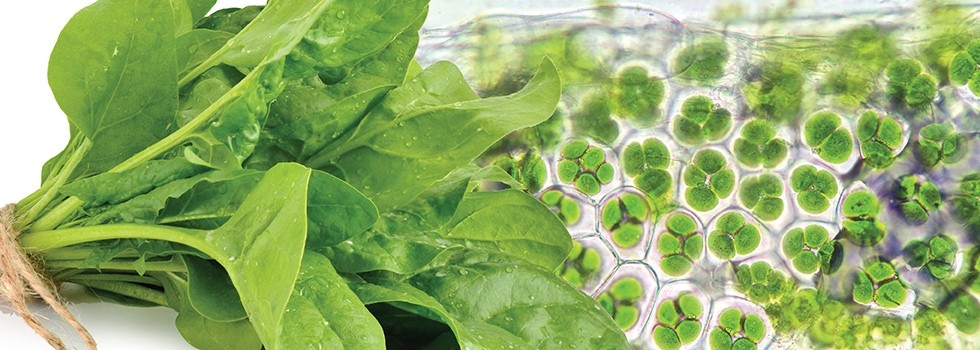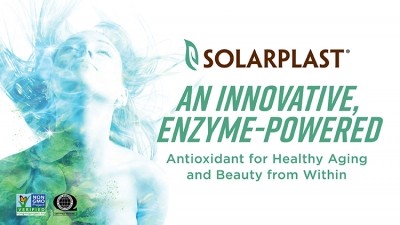Promotional Features
The chloroplast connection: Achieving healthy longevity via protein folding
The key difference between simply aging and healthy aging is rate and quality of processing for regeneration and maintenance (homeostasis). Proteins keep the body functioning on numerous levels; when proteins lose strength, the body begins to age. The weaker the proteins become, the more dysfunctional and slower are healing, regeneration and normal functioning. Protein weakening is often caused or exacerbated by free radicals, and there is a new, plant-based technology that supports viability of proteins.
The oxidant pathway to aging
As the human body ages, accumulated exposure to external and internal elements that create and aggravate free radicals cause not only increasing damage to cells throughout the organism, but also impacts energy production – the fuel we need for power throughout our days. These rampant free radicals affect the body’s mitochondria, which produce energy by combining food (calories) and oxygen to generate adenosine triphosphate (ATP), the “master energy molecule.”
Free radicals are truly everywhere. We cannot feel them as they enter our bodies to do their destructive work, as we will with pathogenic bacteria (colds, norovirus, bronchitis, etc.). Free radicals are linked to many of the lifestyle habits that give us pleasure – sunbathing with inadequate SPF, imbibing too much alcohol or eating our guilty favorites. Even those who live a healthy lifestyle are subject to free radical assault – office cleaning products that they breathe in, smoggy air, second-hand smoke, etc., are rife with free radicals. Further, working out too hard or engaging in physical labor to complete a home project can cause inflammation that causes, you guessed it – free radicals in the body.
Therefore, through time (aging) accumulated damage to the mitochondria lowers their efficiency in converting fuel into energy; this decreased rate of processing energy molecules results in slowed movement, weakened strength. The body finds itself in a state wherein it is functioning with a significant percentage less of the energy it had during youth. Energy is not just felt via purposeful movement (walking, lifting, etc.) but affects proper digestion, metabolism, immunity, kidney and liver function and more.
A healthy protein that is effective in the body is one whose amino acids are tightly coiled or folded. The more it unravels, the less effective the protein becomes. Such an event is called protein unfolding and this is the primary cause of failing proteins contributing to physiological aging. However, a family of compounds known as molecular chaperones thwarts this aging factor by facilitating the folding or refolding of proteins.
Environmental conditions such as heat, humidity and the normal wear and tear of life loosen and fray the structure of proteins. Beyond obvious stressful elements, just the process of existing/living can encourage proteins to unfold, preventing them from functioning optimally. Every process in the body requires proteins, including the digestive pathway; a healthy functioning digestive system has a staff of enzymes (which are specialized proteins) working hard – these include amylase, protease, lipase and lactase, among others.
Chaperones are proteins that galvanize the activities of folding and unfolding as well as the assembly and disassembly of other proteins, allowing them to fold into their original – and biologically desirable – structure. Chaperones can provide stability and restore function to many proteins.
Additionally, chaperones line the intestinal epithelia cells and provide protection from stress arising from unchecked free radicals, heat, inflammation and infection. Chaperones also participate in the repair mechanism of the intestinal tract. One of the biggest advantages is that chaperones along with co-factors such as magnesium and ATP can refold endogenous enzymes – e.g., trypsin, lactase and pepsin – in the intestinal tract. When these enzymes lose their efficacy, this can cause two reactions: physical discomfort (felt more immediately) and poor absorption of vital nutrients (felt later). Aging causes the gradual depletion of enzymes, in expression and stability. Chaperones have been shown to help these refold and regain functionality.
The chloroplast connection
Chloroplasts are organelles within a plant that help it convert sunlight into energy; that energy within the plant helps it grow, survive and thrive. They therefore are the “healthy aging” compounds in plants that have richly green leaves (eg, spinach, kale, escarole, dark lettuce).
Chloroplasts also contain antioxidants that provide the components required to perpetuate the glutathione recycling mechanism (the re-animation and usefulness of spent antioxidants), leaving no harmful byproducts itself.
The chloroplasts in dark leafy greens, like spinach, are a rich source of the antioxidants, energy molecules and chaperones that provide a host of healthy benefits to the body. These chloroplasts and additional chaperones are all encased by a lipid coating, called the spheroplast, within the plant’s cell wall. However, the plant’s cell wall isn’t easily broken down after consumption; only a small amount of the chloroplasts actually break through, severely limiting the amount of nutrients released and absorbed by the body.
Plant extracts could provide a solution; however, the physical extraction process of breaking down the cell wall also damages the spheroplasts, that lipid pouch holding the valuable chloroplasts and chaperones. Once the contents of the spheroplast are exposed to oxygen and moisture, they quickly lose their activity.
Researchers at Deerland Enzymes and Probiotics have developed an innovative process that breaks down the cell wall of leafy greens, while still leaving the spheroplast intact. This process is used to create Solarplast, a product rich in antioxidants, energy molecules and molecular chaperones.
In one study, digestive enzymes lactase, trypsin and pepsin, were subjected to a 50% reduction of activity caused by heat stress. Chaperone refolding effect was evident by adding 100 mg of Solarplast to enzyme solutions either during or after heat stress; the chaperones in Solarplast were able to significantly restore the enzyme activity.
In another study on porcine liver exposed to 500 mg of acetaminophen to simulate cellular damage by reactive oxygen species (ROS), the effect of various antioxidants was measured at 30-minute time intervals. Results indicate vitamin C produced a 24% ROS reduction after 30 minutes with no further reduction at 60 minutes. Solarplast yielded a 67% reduction at 30 minutes and a total of nearly 95% at the 60-minute time point. Though single antioxidants such as vitamin C can reduce liver damage, the Solarplast was shown to be significantly more effective and is able to persist until all reaction components were fully consumed.
Conclusion
Healthy aging is hallmarked by arresting the decline in production rate of cells and other biological functions to achieve youthful homeostasis. Solarplast is a multi-functional supplement that can enhance protein function for extended active well-being for men and women as they age.
Deerland Enzymes and Probiotics is a leading specialty formulator and contract manufacturer of enzyme- and probiotic-based dietary supplements. With a team of industry experts working in a state-of-the-art lab, we’re positioned to serve customers from the initial stages of product conceptualization, through the design phase, final formulation and contract manufacturing.
These statements have not been evaluated by the Food and Drug Administration. This product is not intended to diagnose, treat, cure, or prevent any disease.




